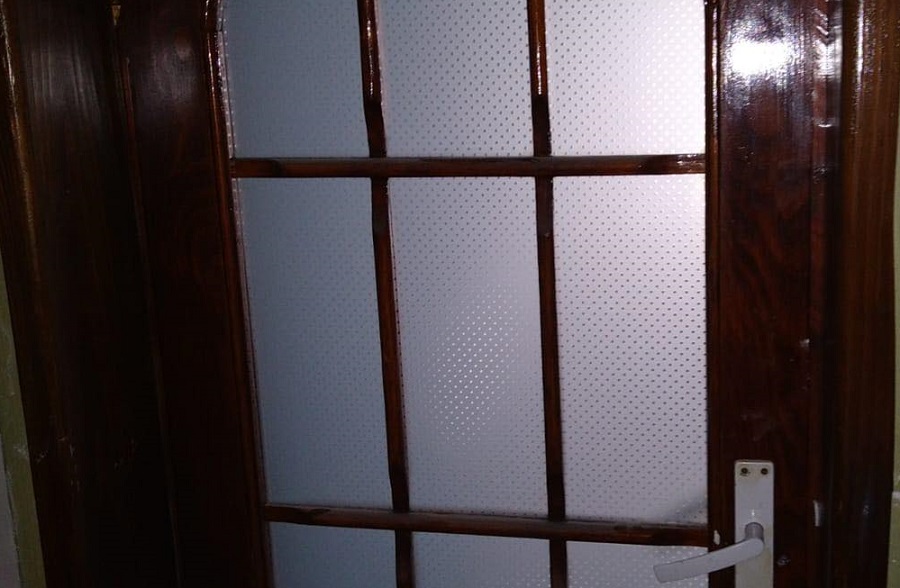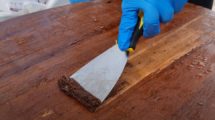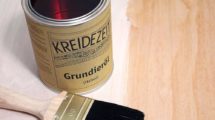Culoarea roșiatică a ușilor a fost prima nemulțumire a doamnei care mi-a cerut sfatul. Dorea să dea lemnului o culoare mai naturală, fără să fie nevoie să le vopsească sau să le șlefuiască. De asemenea, se întreba dacă nu există un material care să deschidă culoarea fără să fie nevoie de o altă intervenție. Din păcate, este imposibil să treci de la o culoare închisă la una deschisă și lemnul să continue să fie vizibil, adică să nu-l vopsești. De asemenea, nu există material de decapare care să ia un strat uniform din finisaj și astfel culoarea ușilor să devină mai deschisă și lemnul mai vizibil. Singura soluție este îndepărtarea totală a lacului și a baițului și refacerea finisajului.

În cazul de față, cum se vede în fotografii, ușile par vopsite cu un lac colorat, iar luciul și aspectul general, precum și faptul că erau uși interioare mă ducea cu gândul la un lac nitrocelulozic. Lacul colorat, aplicat probabil în 2-3 straturi, făcea desenul lemnului prea puțin vizibil. Să le luăm pe rând și să vedem de ce este mai bine să folosim baiț și lac, nu lac colorat și cum poate fi îndepărtat finisajul fără șlefuire sau sandblast.
Lacul colorat dă senzație de plastic și pierde farmecul natural al lemnului
Dacă vă place lemnul și desenul lui natural, lăcuirea cu un lac colorat nu este cea mai bună soluție. Straturile succesive de lac aplicate vor face pelicula din ce în ce mai colorată și cu aspect de plastic, iar desenul lemnului va fi estompat. Pentru a-l evidenția ar trebui colorat întâi în culoarea dorită folosind un baiț simplu și apoi lăcuit cu un lac transparent necolorat.
Un baiț simplu, adică colorant și apă sau solvent, va fi absorbit în lemn și astfel îl va pune în evidență. Dacă există un desen format de lemnul târziu și cel timpuriu, acesta se va vedea și mai bine în urma colorării datorită absorbției diferențiate. Dacă se aplică un lac colorat, vâscozitatea mare va împiedica absorbția, totul așezându-se la suprafață ca o folie de plastic.
Există specii care sunt mai afânate (plop) și care se pot păta atunci când sunt colorate. De asemenea, pot exista defecte care prin colorare vor fi evidențiate. În acest caz se poate aplica un prim strat de lac colorat, dar mai diluat. Absorbția va fi doar de suprafață, desenul va fi evidențiat, dar defectele nu vor fi așa vizibile. Apoi se aplică doar lac transparent necolorat și astfel culoarea nu se va modifica, pelicula va avea transparență, iar lemnul se va vedea.
Paint stripper, paint remover or paint remover
Sunt denumirile sub care găsiți în magazinele de profil soluțiile pentru îndepărtarea peliculelor de lac sau de vopsea. Sunt tot felul de astfel de materiale pe piață, unele mai puternice, altele mai slabe, în funcție de compoziție. Pot fi pentru un anume tip de vopsea sau universale.
Modul de lucru este cam același, indiferent de marcă. Decapantul se aplică cu pensula pe suprafața vopsită și se lasă timpul recomandat. Acest timp variază de la câteva minute, la ore, în funcție de eficiență decapantului, tipul vopselei decapate, grosimea și vechimea stratului. Pentru a putea fi aplicat un strat cât mai gros și a sta bine la aplicarea pe verticală, majoritatea decapanților sunt sub formă de gel. După timpul recomandat, vopseaua ar trebui să se înmoaie și să se umfle astfel încât să poată fi îndepărtată cu o racletă metalică.
Peliculele se lac sau vopsea sunt termoplastice și se înmoaie și cu ajutorul căldurii, folosind o suflantă cu aer cald sau un uscător de păr. Lacul înmuiat se îndepărtează apoi cu racleta, la fel ca mai sus. Dezavantajul este că se lucrează pe porțiuni, iar la suprafețe mari devine dificil. Găsiți here method at length.
Îndepărtarea cu decapant a lacului nitrocelulozic, ca cel de pe ușile menționate, nu ar trebui să pună mari probleme, pentru că este unul dintre cele mai slabe lacuri, cedează foarte repede. Dacă nu se decapează total de la primul strat, se reia procedura. La final se șterge toată suprafața cu alcool și apoi se poate refinisa.

Folosirea diluantului pentru îndepărtarea lacului
În cazul lacului nitrocelulozic, îndepărtarea peliculei poate fi făcută și fără decapant, doar cu diluant nitrocelulozic sau universal. Este mai mult de muncă și cu mai mult miros, dar eficient. Pentru asta, ușa este pusă pe orizontală și se pun deasupra cârpe/prosoape înmuiate în diluant. Cum diluantul este foarte fluid, cârpele îl vor ajuta să rămână pe suprafață mai mult timp și să înmoaie pelicula. După 10-15 min, cârpele se iau, iar lacul se se curăță cu racleta ca mai sus. La final se șterge toată suprafața cu o cârpă cu diluant și se lasă minimum 12 ore. O șlefuire a lemnului înainte de aplicarea baițului va duce la o absorbție mai uniformă. Dacă se preferă culoarea naturală a lemnului, nu se aplică baiț ci se trece direct la lac.
Metoda este mai neplăcută pentru că se degajă mulți vapori și miros de diluant. Este bine de făcut afară sau într-un spațiu dedicat, departe de surse de foc.
Sper să vă fie de folos informațiile. Dacă aveți completări, întrebări sau neclarități, lăsați-le mai jos, în spațiul dedicat. Vă voi răspunde cu siguranță.






























Add comment